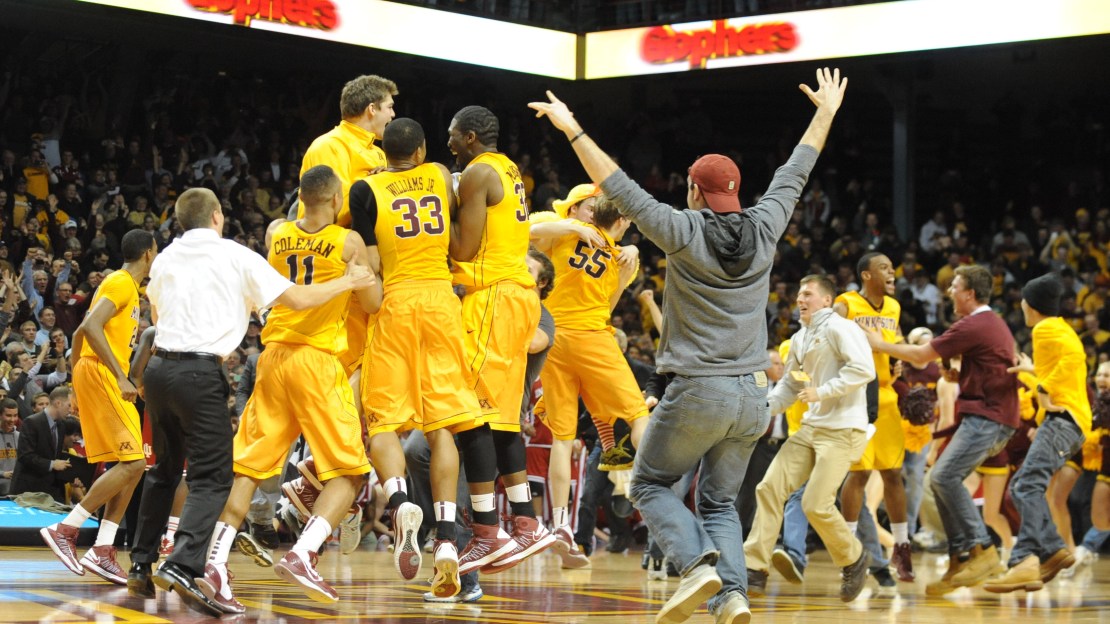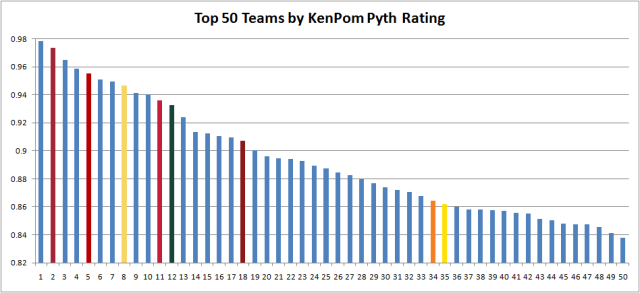BTN.com staff, February 27, 2013
Indiana suffered another road loss to a previously scuffling squad, this time falling at Minnesota by four points. Much has been said about Cody Zeller's lack of offensive production on this night (nine points, four turnovers, five fouls), but the Hoosiers scored quite well with their big man scuffling.
Instead, it was the defensive end where Indiana lost this game, most especially on the defensive glass. The Gophers retrieved a ridiculous 53 percent of their misses and finished nearly every rim opportunity they got. Combined with a surprisingly low turnover rate, it enabled Minnesota to hoist 11 more shots than the Hoosiers, nullifying Indiana's accuracy advantage.
While it is true that Zeller should take some of the blame for the poor rebounding, he and reserve Derek Elston were the only Hoosiers to post double digit defensive rebounding percentages. The rest of the team was a no-show on the glass, most notably Christian Watford and Will Sheehey, who combined for just three defensive rebounds in 42 minutes.
In the nonconference portion of the schedule, Indiana looked like a fantastic defensive rebounding team; in conference play, it has become a weakness. In fact, last night's poor rebounding has landed the Hoosiers in 11th place in Big Ten defensive rebounding percentage, ahead of only lowly Northwestern. Sure, Minnesota is a team that will make a small rebounding problem look huge, but this could be an Achilles' heel for Indiana come tournament time.
Still, let's not get too down on the Hoosiers. This is still one of the best teams in the nation, as driven home by the following chart:
Big Ten teams are denoted by school colors. There's a clear top two in the nation, at least by KenPom rating, and those two are Florida and Indiana (coincidentally, the Gators were also victims of a road upset last night). There's a clear drop-off after the top 13 teams, with five Big Ten teams residing in that top 13 (Indiana, Wisconsin, Michigan, Ohio State, and Michigan State).
I don't think it would be unreasonable to assert that the national champion will emerge from that group of 13 teams (which also includes Louisville, Gonzaga, Duke, Pitt, Kansas, Syracuse, and Miami). For all the talk of parity in the game right now, these numbers show a clear stratification of contenders and pretenders, and most of the contenders are the game's usual suspects.
Minnesota is right there in the next tier, checking in at 18th, with Illinois and Iowa at 34th and 35th. The Gophers needed this win, not so much for their resume, but more for their state of mind. Truth be told, Minnesota was probably going to get to 9-9 even if it lost this game. What this win changes is the attitude around the program. No longer are the Gophers limping to the finish line; even if they stumble once and still finish at 9-9, Tubby Smith's charges can point to a recent win over one of the nation's best teams as they enter the NCAA tournament.
Elsewhere, Nebraska did its part in Wisconsin's bid to post the lowest defensive efficiency of the tempo-free era, as the Huskers scored only 46 points in Madison. This was a typical defensive performance by the Badgers, as they defended without fouling and grabbed nearly every available defensive rebound. The Huskers shot poorly all over the court, even converting a pathetic 37 percent of their shots at the rim. That was largely thanks to having six of those looks swatted. Jared Berggren was a big part of that, as his four blocks made him the all-time Wisconsin leader in the category.
On the other end, the Badgers bombed away from deep, making nearly half of their 25 three-point attempts. Sam Dekker and Ben Brust led that charge, combining for 32 points on 15 shots. Ryan Evans unleashed a new weapon, the jump-shot free throw, on his way to 14 points.
I can't say I've seen a player go this route before, and it doesn't really make a lot of sense. After all, it's not like Evans is a fantastic mid-range shooter. I guess when you're shooting 41 percent on free throws, anything is worth a try, but I'd probably go granny-style first. He did go two-for-two, and I'll be very interested to track his percentage moving forward. Kudos to Evans for at least trying something different, even if it looks a little unorthodox.
With this defensive performance, Wisconsin moves even closer to having the best Big Ten defense of the tempo-free era. As we did last week, let's see where the Badgers' defense stacks up when normalized for scoring environment:
| Team | Season | Big Ten Average Efficiency | Team's In-Conf Defensive Efficiency | DE+ |
| Wisconsin | 2013 | 101.1 | 88.9 | 87.9% |
| Michigan State | 2012 | 103.8 | 92.3 | 88.9% |
| Wisconsin | 2008 | 101.8 | 91.1 | 89.5% |
| Illinois | 2007 | 102.1 | 92.5 | 90.6% |
| Illinois | 2009 | 102.3 | 92.8 | 90.7% |
| Minnesota | 2005 | 103.2 | 93.8 | 90.9% |
| Wisconsin | 2004 | 103.3 | 94.1 | 91.1% |
| Wisconsin | 2010 | 102.8 | 94.2 | 91.6% |
| Iowa | 2006 | 102.5 | 94.5 | 92.2% |
| Illinois | 2003 | 101.0 | 93.3 | 92.4% |
| Purdue | 2011 | 107.5 | 99.9 | 92.9% |
Indeed, 2012-13 Wisconsin now has the best defensive efficiency of the tempo-free Big Ten, both in raw terms and in adjusted terms. The Badgers' remaining opponents currently rank third, ninth, and 12th in offense efficiency; amazingly, Wisconsin's raw defensive efficiency could actually go down from here.
Tonight, it's a doubleheader on BTN, starting with the 5:30pm CT tip of Michigan at Penn State. The Nittany Lions have been playing better as of late, and they did hang with the Wolverines in Ann Arbor ten days ago. Is there a chance they pull off the stunner? I'd be truly shocked.
At 7:30pm CT, Purdue visits Iowa in a must-win game for the Hawkeyes. The Boilers took the first meeting in West Lafayette in overtime thanks to some awful Iowa shooting. Expect a better showing for the Hawkeyes this time around.








